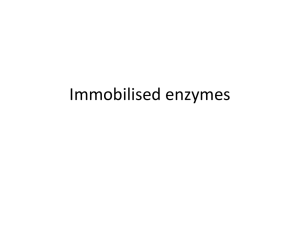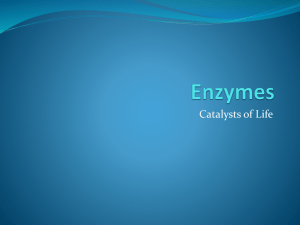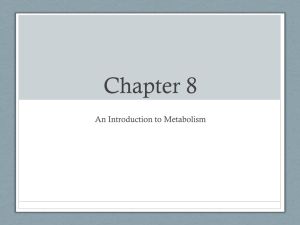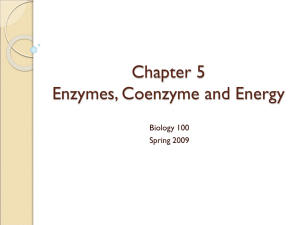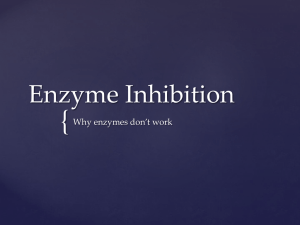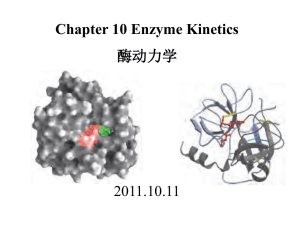+ Enzyme Inhibitors
advertisement
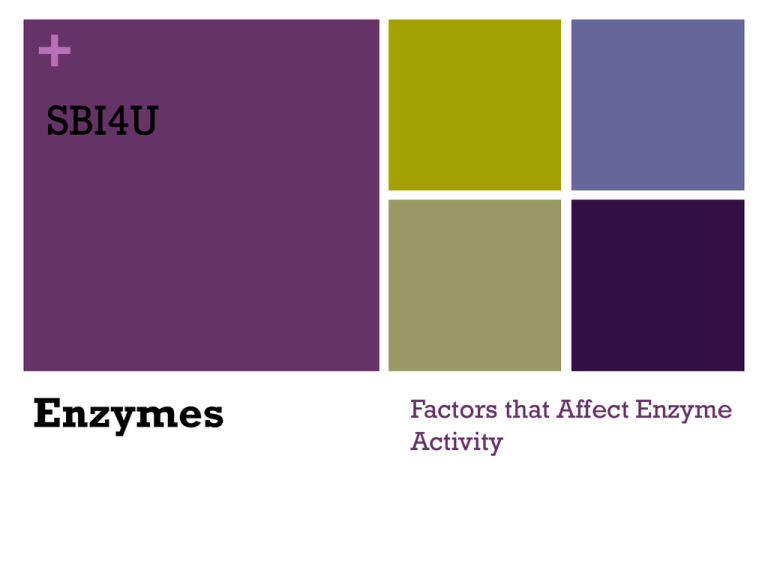
+ SBI4U Enzymes Factors that Affect Enzyme Activity + Factors that Affect Enzyme Activity (reaction rate) The factors we will test for the enzyme lab are: pH temperature substrate concentration enzyme concentration + Enzyme is said to be denatured – no longer a catalyst + + + + Enzyme is said to be denatured – no longer a catalyst + + + Other Regulators of Enzyme Activity Enzyme Cofactors Non-protein, bound May to enzyme be organic or inorganic ions Enhance change enzyme activity - “helper” enzyme active site shape make active site more reactive Examples of Inorganic Cofactors Mg in Chlorophyll Fe in heme group of hemoglobin Organic Cofactors Active site Coenzymes e.g., NAD Prosthetic group (perm. attached) Active site Enzyme Coenzyme (detaches) Prosthetic Groups e.g., FAD Enzyme Important Organic Cofactors Nicotinamide Adenine Dinucleotide (NAD) coenzyme derived from vitamin B3 Coenzyme e.g., NAD carries and transfers electrons and functions as oxidizing agent in redox reactions Active site Coenzyme (detaches) Enzyme Important Organic Cofactors Flavin Adenine Dinucleotide (FAD) Active site prosthetic group Prosthetic group (perm. attached) Enzyme like NAD, FAD functions as a reducing agent in cellular respiration and donates electrons to the electron transport chain Prosthetic Group e.g., FAD + Covalent Modulation Enzymes can be activated or inactivated by covalent modification. A common example is phosphorylation of an enzyme (addition of a phosphate group to the amino acids serine, threonine, or tyrosine) mediated by another enzyme called a kinase . The phosphorylation is reversible, and other enzymes called phosphatases typically catalyze the removal of the phosphate group from the enzyme. Covalent Modulation P HSL Glycerol + P FA Triglyceride (TG) FA HSL HSL + H2O (hydrolysis) HSL Hormone-sensitive lipase (HSL) is phosphorylated during fasting or exercise to catalyze the hydrolysis of TGs to release FAs FA Glycerol Fasting/ exercise FA FA FA Diglyceride + Enzyme Inhibitors Enzymes may become deactivated Temporarily or Permanently Types of Inhibitors Reversible Inhibitors Irreversible Inhibitors + Reversible Inhibitors Used to control enzyme activity Involves the substrate or the end product of the reaction For example: a build up of the end product – called feedback inhibition http://highered.mcgrawhill.com/classware/ala.do?alaid=ala_1032273 + Competitive Inhibitors Competitive Inhibitors have a similar shape as the substrate Compete with the substrate to bind to the active site, but no reaction occurs Block the active site so no substrate can fit Competitive Inhibition + Non-Competitive Inhibitors Binds to a different site on the enzyme Does not compete with the substrate to bind to the active site Two ways to non-competitively inhibit the enzyme: 1. slow down the reaction or 2. changes the shape of the active site (allosteric inhibition) Which of the following diagrams represents allosteric inhibition? (a) Reaction Substrate active site enzyme (b) Inhibition Substrate Substrate binds with the active site of enzyme Reaction occurs and product molecules are produced active site enzyme Inhibitor Inhibitor binds with the inhibitor site of the enzyme and changes the structure of the active site Inhibitor prevents binding of the substrate by changing the active site shape (a) Reaction + Substrate enzyme active site Inhibitor site (b) Inhibition enzyme Substrate binds with the active site of enzyme Reaction occurs and product molecules are produced active site Inhibitor site Inhibitor Inhibitor binds with the inhibitor site of the enzyme Substrate may still bind with the enzyme but the reaction rate is reduced Recap - Distinguish between competitive and non-competitive inhibition Competitive inhibitor competes with the substrate for binding to the active site of the enzyme and prevents reaction Non-competitive inhibitor does not compete for the active site, binds to a different site, either slows down or completely prevents reaction. Recap cont. Explain how allosteric inhibitors differ from other noncompetitive inhibitors: While non-competitive inhibitors reduce enzyme activity and slow down the reaction rate, allosteric inhibitors block the active site altogether and prevent its functioning completely + Irreversible Inhibitors Also called poisons For example: certain heavy metals E.g., cadmium, lead, mercury Retained in the body and lost slowly Cyanide is a poison that prevents the activity of cytochrome C oxidase, an enzyme in the electron transport chain in the cell. It therefore inhibits ATP production and cellular respiration. Cytochrome c oxidase Why are enzymes so tightly regulated by co-factors and inhibitors? Control of Metabolism Biochemical reactions are controlled in part by the specificity of substrate binding, but the human body could not function if all enzymes were present together and all operating maximally with no regulation. There would be biochemical chaos with substances being synthesized and degraded at the same time. Instead, the body tightly regulates enzymes through metabolic pathways and by controlling specific enzymes within a pathway. This approach allows an entire pathway to be turned on or off by simply regulating one or a few enzymes. Metabolic pathways can also be regulated by switching specific genes on or off. Since the tight control of enzyme activity is essential for homeostasis, any malfunction (mutation, overproduction, underproduction or deletion) of a single critical enzyme can lead to a genetic disease. Lethal illness can be caused by the malfunction of just one type of enzyme out of the thousands of types present in our bodies. E.g., the disease phenylketonuria (PKU) results from a mutation of a single amino acid in the enzyme phenylalanine hydroxylase, which catalyzes the first step in the degradation of phenylalanine The result is a build-up of phenylalanine and related products and can lead to a number of ill effects Why is it important to know how enzymes are regulated? Enzymes play a critical role in everyday life. Many heritable genetic disorders occur because there is a deficiency or total absence of one or more enzymes. Routine medical tests monitor the activity of enzymes in the blood,involve the use of enzymes to diagnose diseases, and many of the prescription drugs (e.g., penicillin,) exert their effects through interactions with enzymes. Enzymes and their regulators are important tools in medicine, agriculture, and food science. The application of enzymes in food processing and pharmaceuticals is a multi-billion dollar industry! Biotechnology is influencing countless aspects of our daily lives. The use and impact of enzymes in these sectors will be the focus of your biochemistry unit task.

